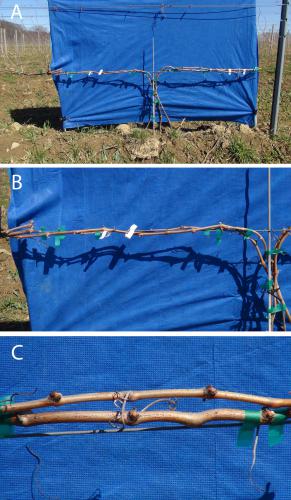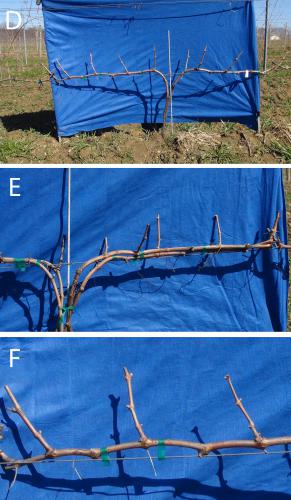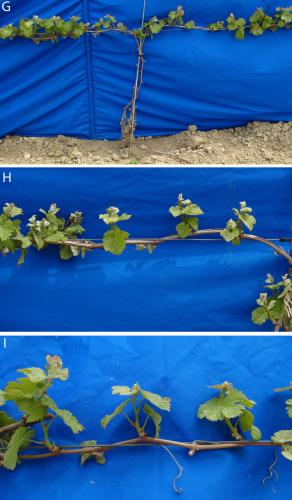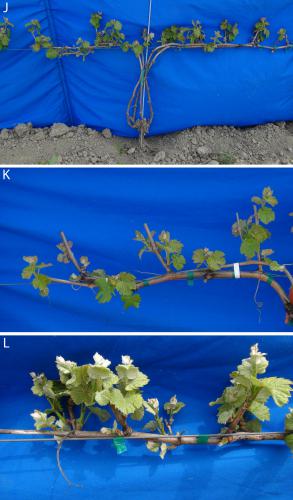Pruning is underway in northwest Michigan vineyards
A review of grapevine pruning, and upcoming virus management and enology workshop for successful grape growing and winemaking.
March is here, and for Michigan grape growers that means pruning is around the corner. Grapevine pruning is an annual practice where nearly 90 percent of the previous year’s growth is removed, but it is the most cost-effective method to maintain the vine form and control fruit and quantity. Seasoned growers and farm workers likely understand the counterintuitive concepts of pruning, but beginners may need a review to understand how removing a substantial amount of vine/canes will produce an optimum grape product.
There are two main types of pruning used on mature grapevines: cane- and spur-pruning. These two pruning methods differ in the number and length of retained canes that will be used to produce the coming year’s fruit. Typically, after cane-pruning a mature grapevine, nearly all previous year’s canes are pruned away with the exception of two to four fruitful canes. These retained canes are tied to the trellis wire, and the buds (nodes) on the retained canes will produce the current growing season’s shoots and fruit. Generally, after spur-pruning a mature grapevine, all canes from the previous year are pruned down to two to five buds (nodes) or cane extensions called spurs.


Whole vine (A), tied cane (B) and close up of buds (C) on cane-pruned grapevine before bud break. Whole vine (D), tied cane (E) and close up of buds (F) on spur-pruned grapevine before bud break.


Whole vine (G), tied cane (H) and close up of buds (I) on cane-pruned grapevine after bud break. Whole vine (J), tied cane (K) and close up of buds (L) on spur-pruned grapevine after bud break.
Both pruning types have their advantages and disadvantages. For example, cane-pruning is more cost-intensive than spur-pruning because it requires annual manual removal of previous year’s fruiting cane followed by selecting and tying the coming year’s fruiting cane. Also, it is worth noting that during cane-pruning, there is a risk of knocking off or otherwise damaging buds when wrapping and tying canes on the wire, especially those that are tied later in the spring when buds are more fragile. Spur-pruning, on the other hand, does not share the same risk of bud damage and instead uses a semi-permanent cordon from which fruiting spurs originate and allows for safer manual pruning and also mechanized pruning. However, because spur-pruning utilizes only the most basal two to five buds per cane for fruiting, some cultivars with low basal bud fruitfulness do not reach their fruiting potential when they are spur-pruned.
Historically, growers have used cane-pruning in northwest Michigan vineyards because this technique has fewer above-ground vine/buds that are susceptible to damaging low temperatures during the dormant season. Furthermore, the 2014 and 2015 winters had extreme low temperatures caused by advective freeze events known as “Polar Vortices” that resulted in catastrophic grapevine damage across eastern North America. Research conducted during a two-year, post-vortex retraining study that evaluated how to best return vineyards to pre-damage crop production found that cane-pruning produced more mature fruit at lower cost than spur-pruning. These results show promise for using cane-pruning in Michigan’s short and variable growing season.
In the current labor climate, no matter which type of pruning is implemented, the limiting factor for most apple, cherry and grape producers to prune in a timely manner is labor availability. To address this limiting factor, Michigan State University Extension organized the 2018 Agricultural Labor Meeting on March 7, 2018, to cover issues including labor recruiting, legal updates, farm worker housing and child care, and food safety.
Since there have been no confirmed reports of significant grapevine bud damage due to cold, it is safe to assume northern Michigan vines will have normal bud break and a flush of shoot growth in May. Historically in northwest Michigan, grape buds break and release shoots in mid-May. At this time, shoots, leaves and flower clusters are susceptible to many viral pathogens that can cause a decline in productivity over the life of the vineyard.
View viticulture practice videos produced by Thomas Todaro covering grapevine pruning, canopy management, vine replacement after winter injury, winter protection of grapevines by hilling and cane burial.



 Print
Print Email
Email




